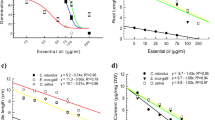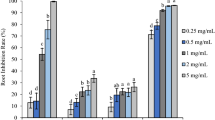Abstract
Aerial parts of Xanthium italicum in an air tight container greatly inhibited root elongation of radish, implying that this invasive plant could release biologically active volatile organic compounds (VOCs) into the environment to affect other plants’ growth. This phenomenon was further studied by evaluating the phytotoxic effects of X. italicum essential oil against two dicot plants, amaranth (Amaranthus mangostanus L.) and lettuce (Lectuca sativa L.), and two monocot plants, wheat (Triticum aestivum Linn) and ryegrass (Lolium multiforum), and analyzing the chemical composition of the oil. Among the 4 test species, amaranth was the most sensitive plant, 0.5μl/mL essential oil application resulted in a 50% reduction on root elongation, and 2.5 μl/mL essential oil almost completely inhibited its seedling growth. Wheat was the least sensitive species, whose root growth was reduced to 36% of control by 5 μl/mL essential oil. The essential oil exerted moderate inhibitory effect on both lettuce and ryegrass. Compared to a commercial herbicide-Harness, X. italicum oil exhibited stronger phytotoxicity on amaranth, lettuce and wheat, but weaker activity on ryegrass. The chemical composition of the essential oil isolated by hydrodistillation from the aerial parts of X. italicum Moretti was analyzed by GC/MS. Thirty two compounds were identified, representing 94.89% of total oil, which was found to be rich in monoterpene hydrocarbons (60.71%). The main constituents of the oil were limonene (51.61%), germacrene B (6.98%), δ-cadinol (5.94%), β-pinene (5.23%), α-caryophyllene (5.1%) and bornyl acetate (3.15%). Bioassay revealed the dominant constituent-limonene, was unlikely the responsible phytotoxic compound due to its low biological activity; rather, there might be other oil constituent( s) that either act alone, or work together, and possibly assisted by synergistic effect, to display the phytotoxic activity. Our results suggested that X. italicum might produce allelopathic VOCs to facilitate its invasion success. This is the first report on the phytotoxic activity and the chemical composition of the essential oil of X. italicum Moretti from China.
Similar content being viewed by others
References
Andreani S, Barboni T, Desjobert J, et al. 2012. Essential oil composition and chemical variability of Xanthium italicum Moretti from Corsica. Flavour and Fragrance Journal, 27: 227–236.
Asplund R O. 1968. Monoterpenes: relationship between structure and inhibition of germination. Phytochemistry, 7: 1995–1997.
Barney J N, Sparks J P, Greenberg J, et al. 2009. Biogenic volatile organic compounds from an invasive species: impacts on plant-plant interactions. Plant Ecology, 203: 195–205.
Borbely V M, Radocz L. 2005. Changing of amounts of allelochemicals in Italian cocklebur (Xanthium italicum Mor.) during the growing season. Allelopathy Journal, 41: 397–403.
Callaway R M, Aschehoug E T. 2000. Invasive plants versus their new and old neighbors: a mechanism for exotic invasion. Science, 290: 521–523.
Callaway R M, Ridenour W M. 2004. Novel weapons: invasive success and the evolution of increased competitive ability. Frontiers in Ecology and the Environment, 2: 436–433.
Casini P. 2004. Allelopathic influences of common cocklebur (Xanthium italicum Moretti) on maize. Allelopathy Journal, 13: 189–199.
David I, Borbely V M, Radocz L. 2005. Changing of amounts of allelochemicals in Italian cocklebur (Xanthium italicum Mor.) during the growing season. Novenyvedelem, 41: 397–403.
Ehrenfeld J G. 2003. Effects of exotic plant invasions on soil nutrient cycling processes. Ecosystems, 6: 503–523.
Esmaeilia A, Rustaiyana A, Akbari M T, et al. 2012. Composition of the essential oils of Xanthium strumarium L. and Cetaurea solstitialis L. from Iran. Journal of Essential Oil Research, 18: 427–429.
Goodall D W, Perry R A. 2009. Arid Land Ecosystems: Volume 2, Structure, Functioning and Management. Cambridge: Cambridge University Press.
Hegazy A K, Farrag H F. 2007. Allelopathic potential of Chenopodium ambrosioides on germination and seedling growth of some cultivated and weed plants. Global Journal of Biotechnology and Biochemistry, 2: 1–9.
Ibrahim M A, Kainulainen P, Aflatuni A. 2001. Insecticidal, repellent, antimicrobial activity and phytotoxicity of essential oils: with special reference to limonene and its suitability for control of insect pests. Agricultural and Food Science, 10: 1795–1895.
Inderjit, Callaway R M, Vivanco J M, et al. 2006. Can plant biochemistry contribute to understanding of invasion ecology? Trends in Plant Science, 11: 574–580.
Inderjit, Evans H, Crocoll H, et al. 2011. Volatile chemicals from leaf litter are associated with invasiveness of a Neotropical weed in Asia. Ecology, 92, 316–324.
Kitayama K, Mueller-Dombois D. 1995. Biological invasion on an oceanic island mountain: do alien plant species have wider ecological ranges than native species? Journal of Vegetable Science, 6: 667–674.
Kourtev P S, Ehrenfeld J G, Häggblom M. 2002. Exotic plant species alter the microbial community structure and function in the soil. Ecology, 83: 3152–3166.
Kovács A, Vasas A, Forgo P, et al. 2009. Xanthanolides with antitumour activity from Xanthium italicum. Zeitschrift für Naturforschung C, 64: 343–349.
Krifa M, Gharad T, Haouala R. 2011. Biological activities of essential oil, aqueous and organic extracts of Pituranthos tortuosus (Coss.) Maire. Scientia Horticulturae, 128: 61–67.
Kuiters A T. 1990. Role of phenolic substances from decomposing forest litter in plant-soil interactions. Acta Botanica Neerlandica, 27: 329–348.
Levine J M, Vilà M, D’Antonio C M, et al. 2003. Mechanisms underlying the impacts of exotic plant invasions. Proceedings of the Royal Society of London Series, 270: 775–781.
Li N, Zhu L N, Zhai Q, et al. 2010. A new alien invasive plant-Xanthium italicum Moretti in Liaoning province. Plant Quarantine, 24: 49–52.
Liu Q R, Yu M, Zhou Y L. 2002. A preliminary study on the invasive plants in Beijing. Journal of Beijing Normal University: Natural Science, 38: 399–404.
Martino L D, Mancini E, Almeida L F R. 2010. The antigerminative activity of twenty-seven monoterpenes. Molecules, 15: 6630–6637.
Ministry of Agriculture of the People’s Republic of China. 2007. The Directory of Imported Plant Quarantine Pests of the People’s Republic of China. Beijing: The Ministry of Agriculture Bulletin No. 862 of the People’s Republic of China.
Mounira K, Gharad T, Haouala R. 2011. Biological activities of essential oil, aqueous and organic extracts of Pituranthos tortuosus (Coss.). Scientia Horticulture, 128: 61–67.
Rice E L. 1984. Allelopathy, 2nd ed. New York: Academic Press.
Scherer R, Wagner R, Meireles M A A, et al. 2010. Biological activity and chemical composition of hydrodistilled and supercritical extracts of Xanthium strumarium L. leaves. Journal of Essential Oil Research, 22: 424–429.
Shanab S M M, Shalaby E A, Lightfoot D A, et al. 2010. Allelopathic effects of water hyacinth (Eichhornia crassipes). PLoS One, 5: e13200, doi:10.1371/journal.pone.0013200.
Shao H, Huang X L, Wei X Y, et al. 2012. Phytotoxic effects and a phytotoxin from the invasive plant Xanthium italicum Moretti. Molecules, 17: 4037–4046.
Shao H, Peng S L, Wei X Y, et al. 2005. Potential allelochemicals from an invasive weed Mikania micrantha H.B.K. Journal of Chemical Ecology, 31: 1657–1668.
Taher H A, Ubiergo G O, Talenti E C J. 1985. Constituents of the essential oil of Xanthium cavanillesii. Journal of Natural Products, 48: 857–857.
Wang R, Wan F H. 2010. Prediction of the potential survival area of Xanthium Italicum in China. Acta Prataculturae Sinica, 19: 222–230.
White C S. 1994. Monoterpenes: their effect on ecosystem nutrient cycling. Journal of Chemical Ecology, 20: 1381–1406.
Witte S T, Osweiler G D, Stahr H M, et al. 1990. Cocklebur toxicosis in cattle associated with the consumption of mature Xanthium strumarium. Journal of Veterinary Diagnostic Investigation, 2: 263–267.
Yurkonis K A, Meiners S J, Wachholder B E. 2005. Invasion impacts diversity through altered community dynamics. Journal of Ecology, 93: 1053–1061.
Zhao J. 1995. Physical Geography of China. Beijing: Higher Education Press.
Zuzarte M, Goncalves M J, Cruz M T, et al. 2012. Lavandula luisieri essential oil as a source of antifungal drugs. Food Chemistry, 135: 1505–1510.
Author information
Authors and Affiliations
Corresponding author
Rights and permissions
About this article
Cite this article
Shao, H., Zhang, Y., Nan, P. et al. Chemical composition and phytotoxic activity of the volatile oil of invasive Xanthium italicum Moretti from Xinjiang, China. J. Arid Land 5, 324–330 (2013). https://doi.org/10.1007/s40333-013-0170-2
Received:
Revised:
Accepted:
Published:
Issue Date:
DOI: https://doi.org/10.1007/s40333-013-0170-2




